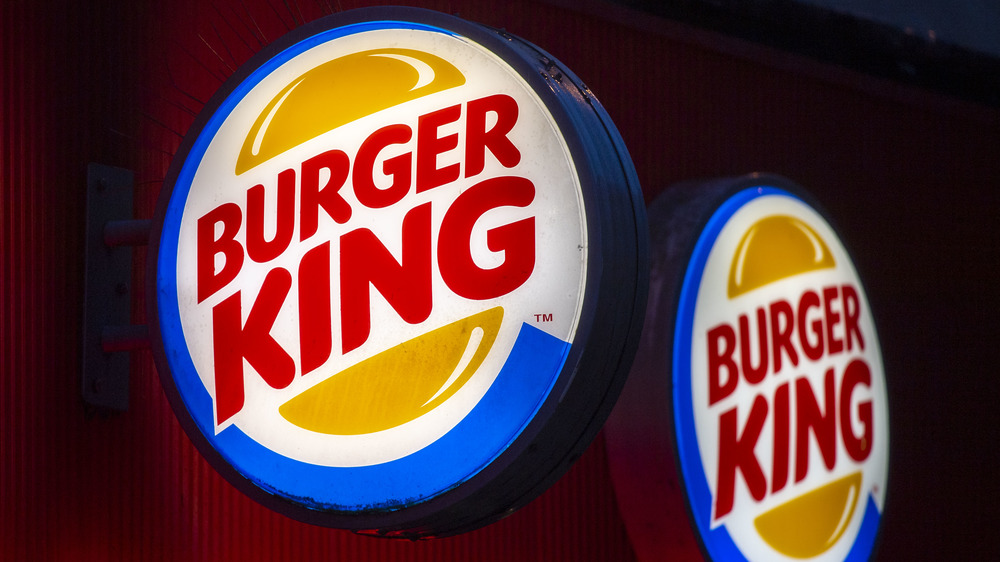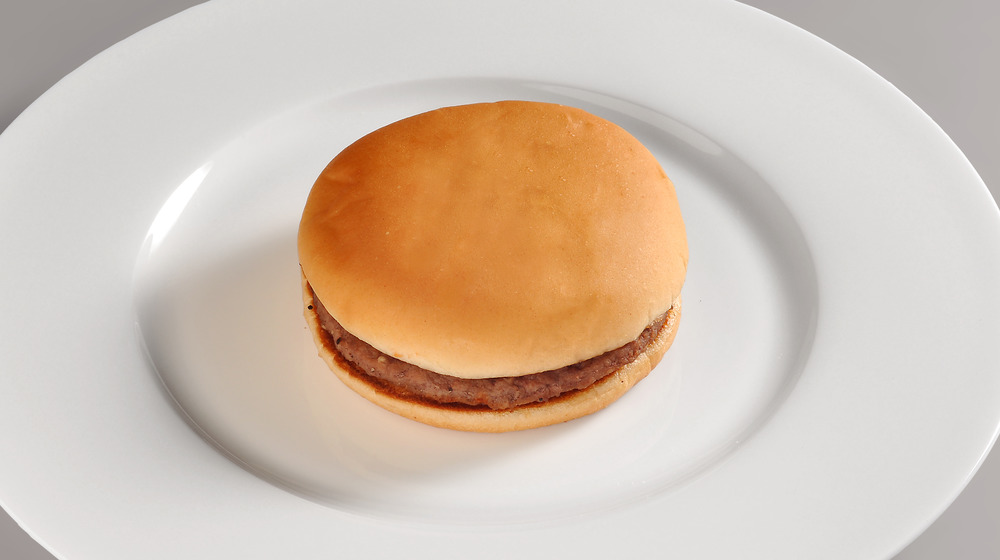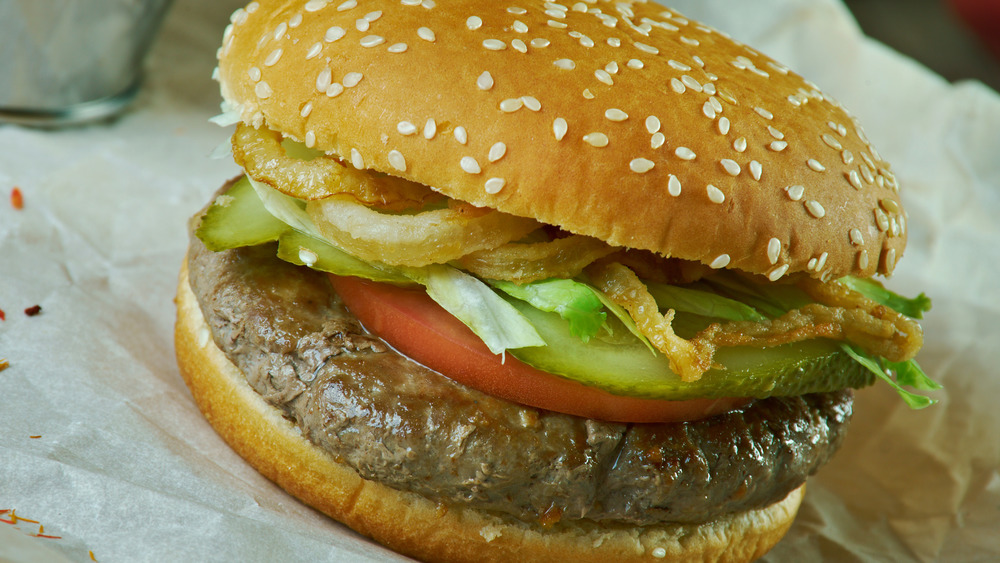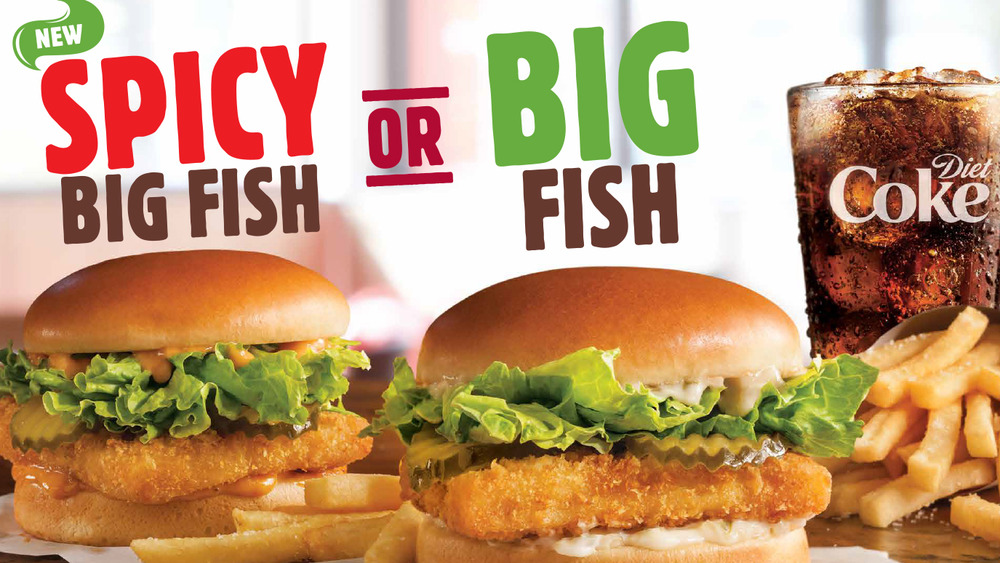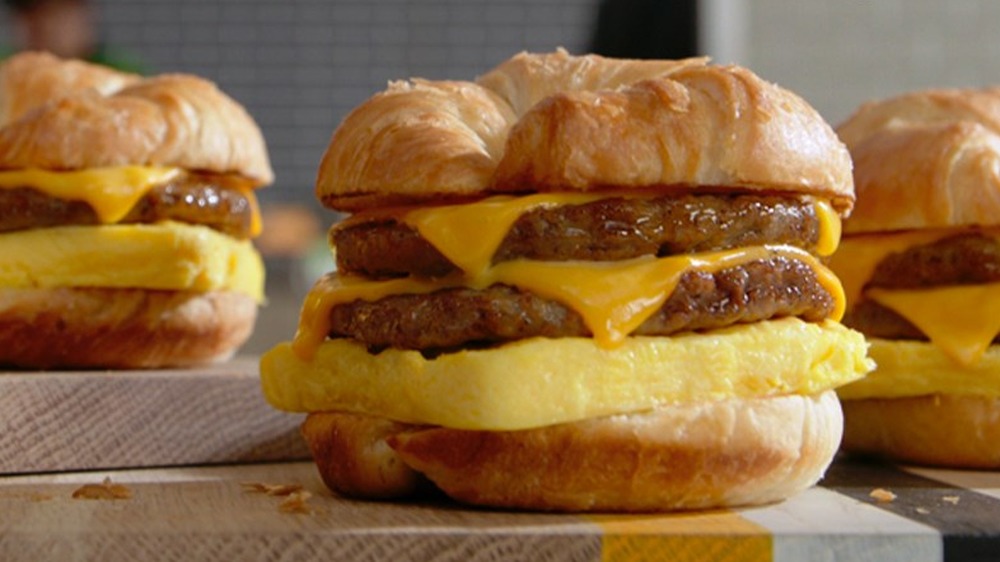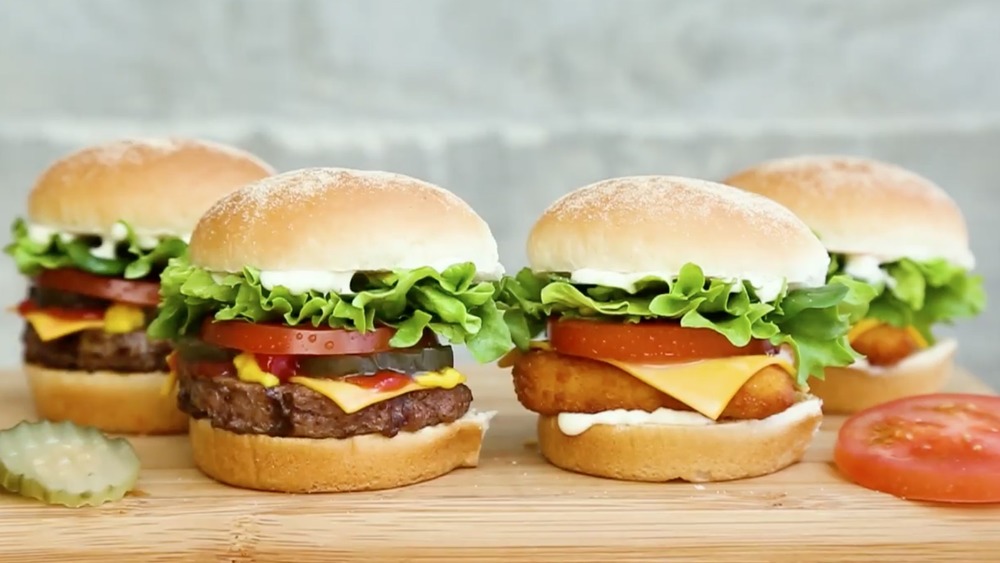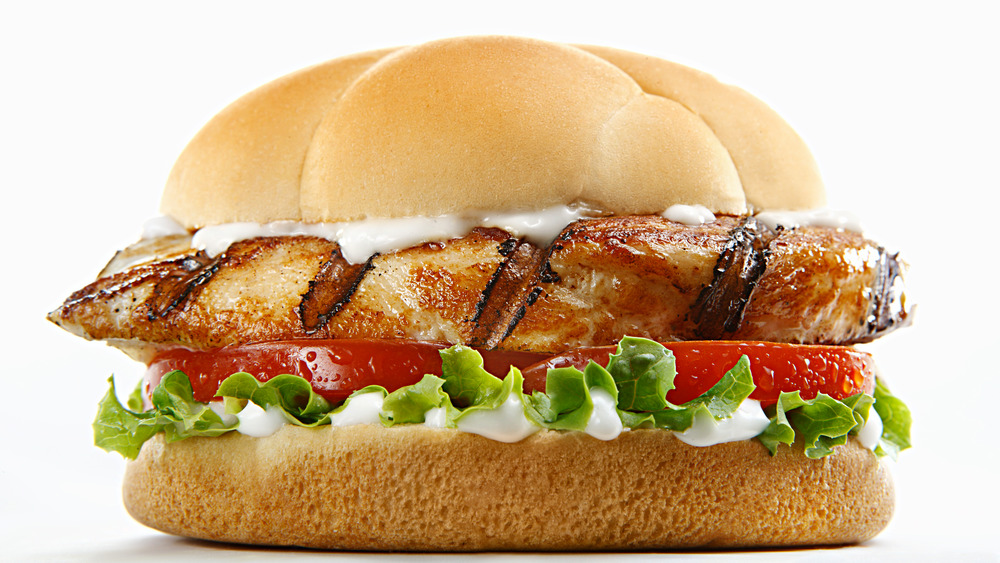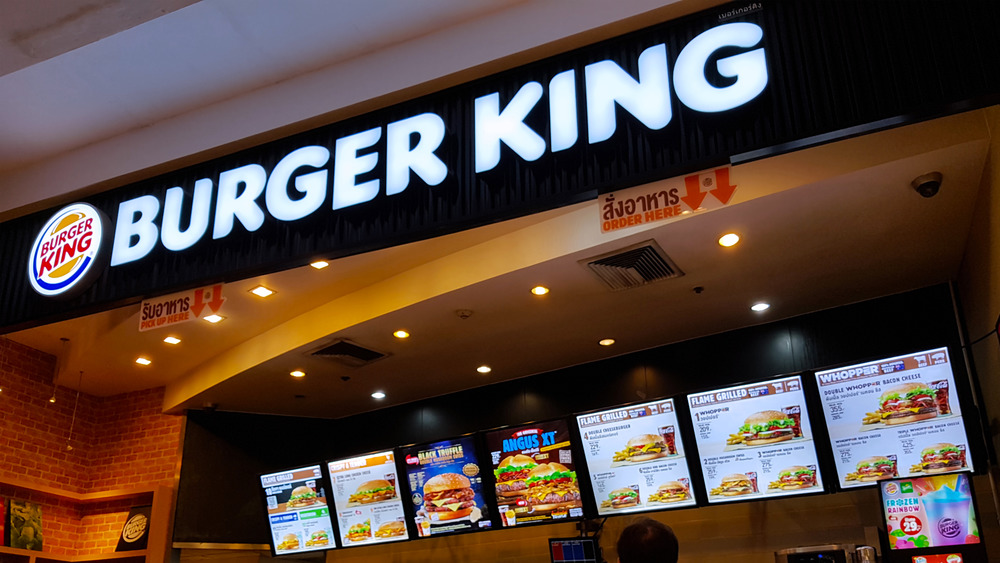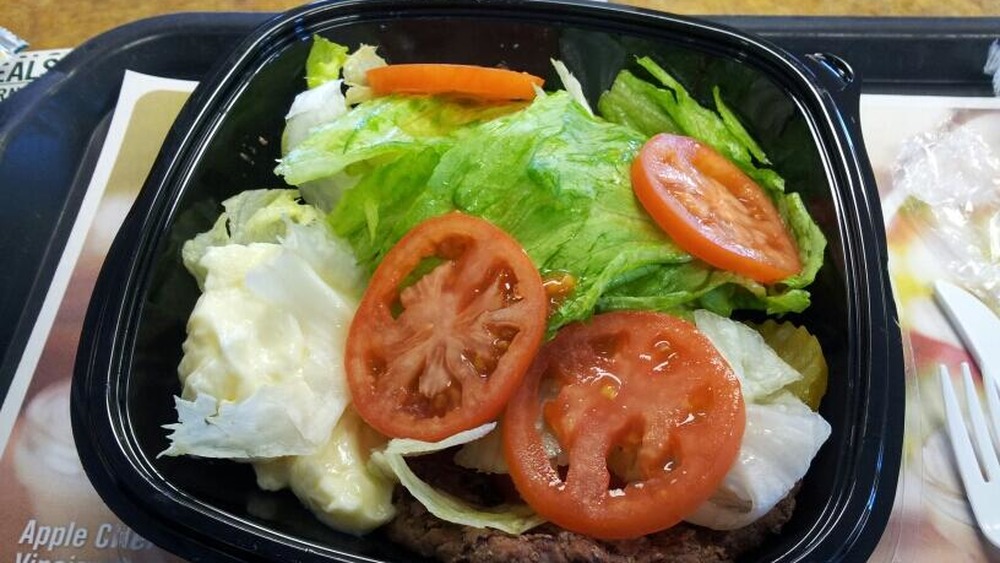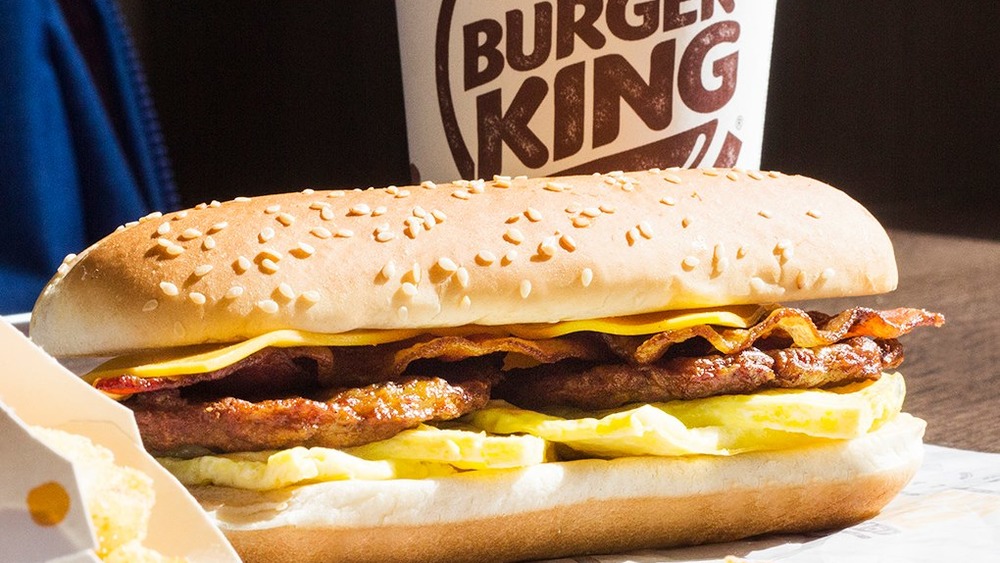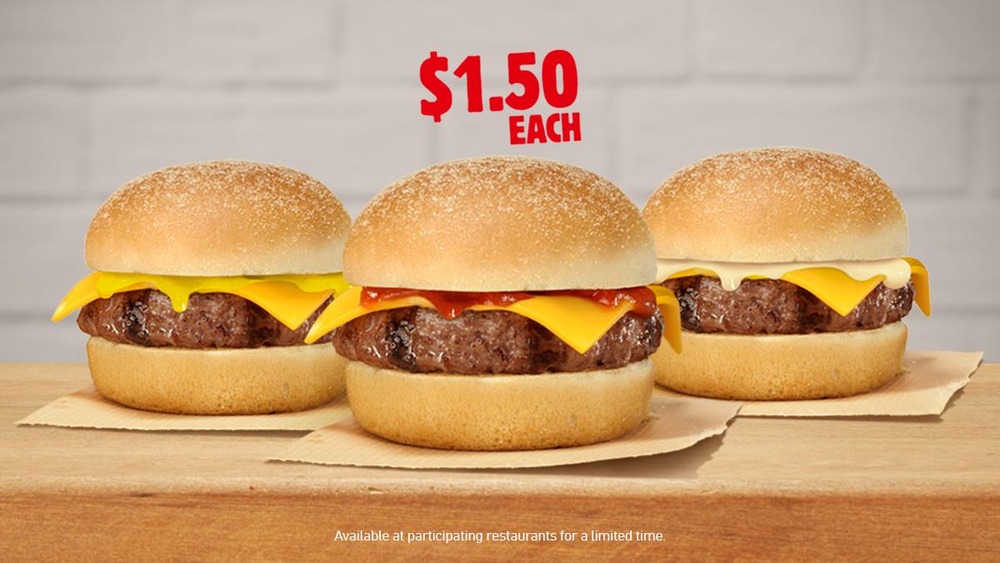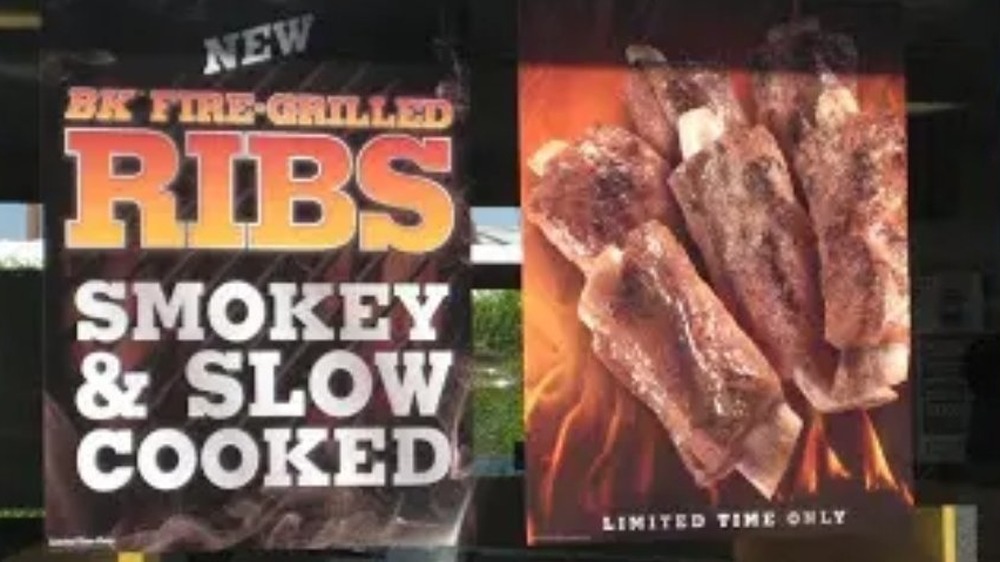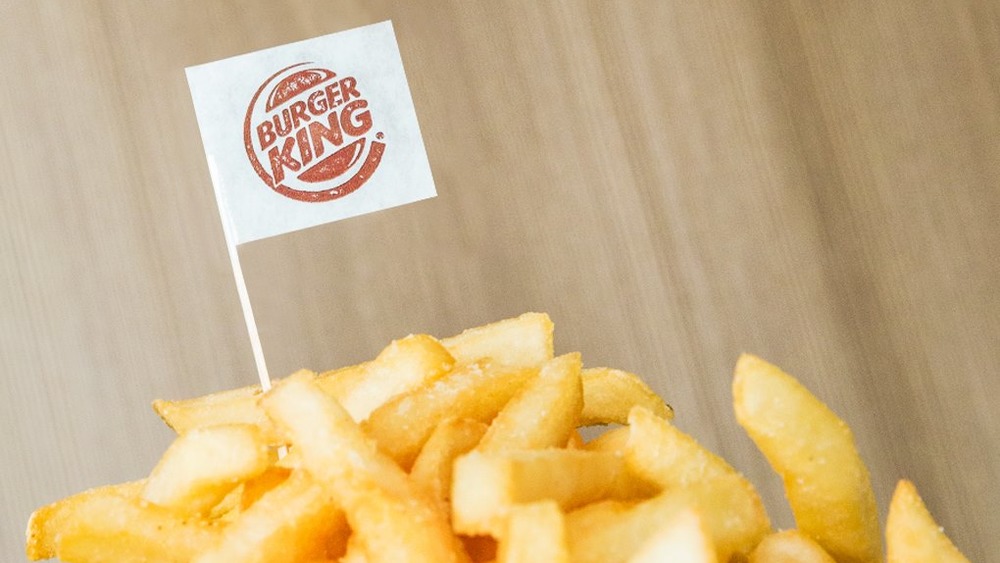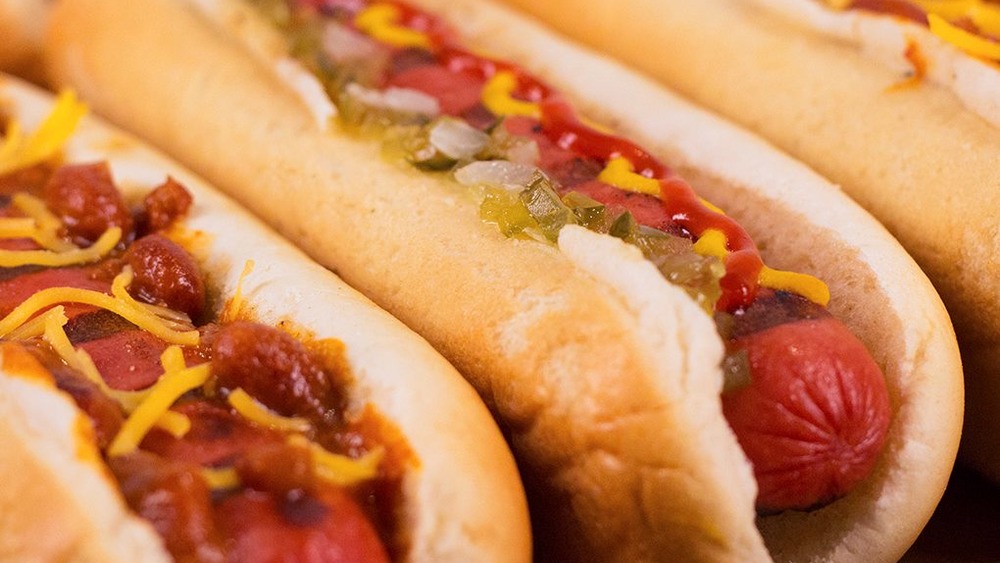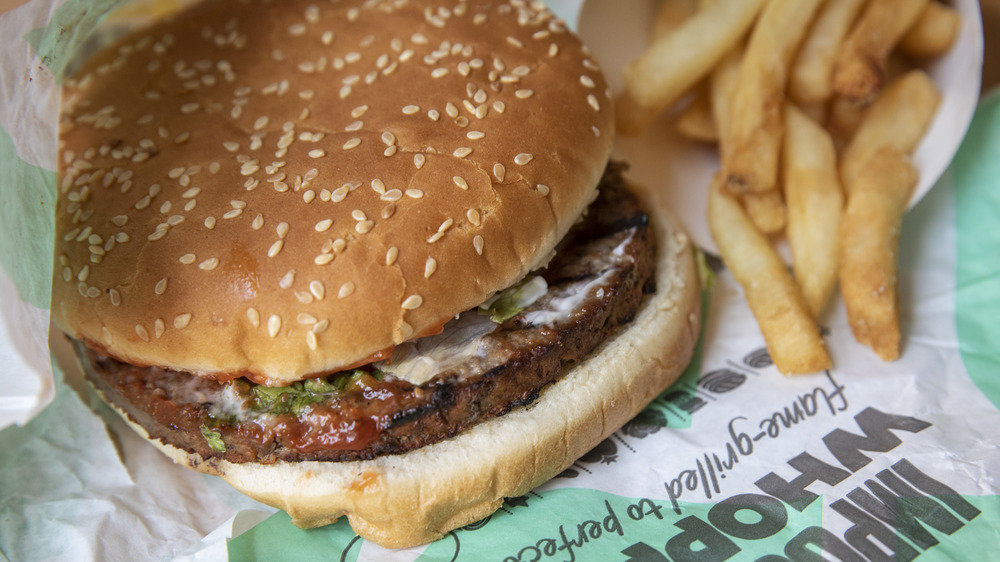What Burger King's Menu Looked Like The Year You Were Born
As of 2019, Burger King operated nearly 19,000 restaurants worldwide, with continual growth since 2009 and a brand value of $7 million. Setting itself apart from the pack of other major fast-food chains with its flame-grilled burgers and giant Whoppers, as well as its sometimes oddball marketing schemes and its (more than) slightly creepy King, Burger King promises to deliver your fast food your way — and the brand has gone to great lengths over the decades to provide a menu that makes that possible.
Over the course of Burger King's nearly 70-year history, it's changed out its menu in a variety of ways while still sticking to the Whopper that's appeared first and foremost on the menu through the years. Burger King has toyed around with breakfast, experienced serious flops, and introduced menu items specifically to compete with other fast-food brands to varying degrees of success.
What was on the BK menu when you were born? Here's a look at how the Burger King menu has evolved since the 1950s.
1953-1956: Burger King gets its start under another name, with a nod to a special type of tech
In 1953, Burger King was launched in Jacksonville, Fla. At the time, the restaurant was called Insta-Burger King, a name that the founders derived from a special kind of grilling machine, the Insta-Broiler. The Insta-Broiler was a futuristic (for the time) piece of kitchen tech that cooked burger patties via radiant heat while toasting the burger buns simultaneously. The founders claimed that the appliance could cook 400 burgers per hour and that it ensured each burger was cooked uniformly, while retaining the meat's juices and preventing patty shrinkage.
So, already at the beginning, Burger King was setting itself apart from its competitors through its cooking methods. The menu, though, at that time, did not include the Whopper. It would be a few years until that appeared on the Insta-Burger King menu. Instead, diners found 18-cent burgers, alongside milkshakes, French fries, and fruit pies. You could also get a double beef burger for an up-charge of a dime.
1957-1977: The Whopper appears and sets the stage for the next 20 years
The Insta-Burger King Whopper appeared on the menu in 1957. Compared to the original 18-cent burger, the Whopper featured a larger patty and was topped with a special sauce, cheese, lettuce, tomato, and pickles. The larger burger came with a larger price tag, too: a whopping 37 cents.
At the time, the Insta-Burger King restaurants still used the Insta-Broiler for cooking up its burger patties, but that would change when two franchise owners bought out the entire Insta-Burger King company in 1959 (via The Balance Small Business), and switched all locations over to a gas grill contraption of their own creation, which they called a flame broiler. What exactly was it? Essentially (and these flame broilers are still used today) it was a broiler with a flame grill inside. You load patties onto a tray, insert them into the broiler, and then the flame grill does all the cooking, according to an employee who shared the process on Reddit. In addition to this major change, the new owners of the company would change up the BK name, dropping the "Insta" from the beginning just as easily as they dropped the Insta-Broiler from their kitchens.
For the next two decades, the Burger King menu would remain much the same, with the Whopper taking center stage and available in a variety of formats (junior, double, etc.) alongside French fries, onion rings, shakes, and soft drinks.
1978-1982: Burger King fights for fast-food supremacy with new menu additions
As other fast-food chains began to expand their menus in the late 1970s and early 1980s, Burger King realized it would need to do much the same if it wanted to remain relevant against competitors such as McDonald's and Wendy's. So, new menu items were added, as noted by Encyclopedia.com, mostly thanks to new executives. At the time, Burger King was owned by Pillsbury (yep, of Dough Boy fame), and the company brought in a previous McDonald's executive to both "crack down" on wayward franchisees and bring Burger King into a new age, a task that included several new menu items, as well as international expansion.
In order to appeal to an older demographic, Burger King introduced an array of new sandwiches to go alongside its burgers, including a fish sandwich, chicken sandwich, ham and cheese sandwich, and steak sandwich. The effort boosted restaurant traffic by 15 percent. Then, in response to McDonald's offering breakfast, Burger King began breakfast testing as well, though it would be a few years before the chain would stumble upon a winning breakfast formula.
1983-1986: Breakfast becomes big and Burger King watches its waistline
Burger King's breakfast success finally happened in 1983, when the Croissan'wich made its appearance. Still popular today, the Croissan'wich is and was exactly what it sounds like: a breakfast sandwich that uses a croissant as a bun. The Croissan'wich comes in several varieties, including sausage, bacon, and ham options, all with egg and cheese. But the breakfast success didn't end there; as noted by Encyclopedia.com, in 1985, Burger King introduced its French toast sticks, proving that Americans were interested in a French-inspired fast-food breakfast.
Also in 1985, Burger King began to revamp its image, adding salad bars and a "light" menu to its restaurants, while also remodeling most of the dining rooms to feature less plastic furniture and more wood furnishings and plants. The revamp coincided with BK's expansion throughout Europe.
One big success for BK in the mid-1980s? Chicken tenders. Introduced in 1986, chicken tenders were an immediate hit at Burger King locations, so much so that restaurants couldn't keep up with demand and the restaurant had to cancel a $30 million ad campaign introducing the menu item.
1987-1989: Burger King goes tiny in an effort to compete against White Castle
In 1987, Burger King turned its attention to a new competitor: White Castle. Where Burger King had always gone big, big, big before, now it needed to go small in an effort to compete against a growing fast-food giant. So, it introduced Burger Bundles, sliders that came in quantities of six and were topped with mustard, ketchup, and pickles, as noted by The Christian Science Monitor. But while the Burger Bundles were popular with kids and Burger King even introduced a chicken variant, there was a problem. The smaller-sized slider patties didn't work well in the automated flame broiler and so Burger King soon canceled the Burger Bundles, making it one of the biggest flops in Burger King history.
However, Burger King would go on to reintroduce the same concept as Burger Buddies, which were two connected, tear-able small sliders, also with mustard, ketchup, and pickles. Presumably to make the slider patty do-able within Burger King's well-oiled cooking line, the chain formulated a patty shaped like a figure eight.
While the Burger Buddies were also discontinued, Burger King would revisit the slider concept time and time again.
1990-2001: Grilled chicken means big business, and Burger King takes on the Big Mac
For the early '90s, Burger King made an attempt to "slim down," when it introduced its very first broiled non-breaded chicken sandwich in 1990, the BK Broiler (via The New York Times). Served on an oat-bran roll, the menu addition was a stark contrast to a lot of the chicken products that were available from other fast-food chains. As such, it was an immediate hit, selling at a rate of a million BK Broilers per day just a month after the sandwich's launch, compared to Burger King's rate of selling 2 million Whoppers per day at the same time. However, this success would not last forever. By 1992, sales for the BK Broiler would be slashed in half, for 500,000 chicken sandwiches sold per day, while Whopper sales remained consistent (though a New York Times article noted that, whenever Burger King decided to advertise the BK Broiler from time to time, sales reliably doubled, returning to launch figures).
But the 1990s weren't only about healthy options for Burger King. In 1997, Burger King introduced the Big King, with two burger patties, two slices of cheese, lettuce, onions, pickles, and King sauce. The Big King was immediately advertised as a competitor to the Big Mac, with ads noting that the sandwich was "like a Big Mac, except it's got 75 percent more beef."
2002: The BK Value Menu is the largest menu change in Burger King history
In 2002, Burger King announced the largest new product and new menu launch in the brand's history, all thanks to the 99-cent BK Value Menu, as noted by South Florida Business Journal. When introduced, the value menu included 11 different items, all of which cost $0.99. However, the value menu wasn't just a compilation of various items already on the regular Burger King menu. It also included six new menu items that had never before appeared in Burger King dining rooms or drive-thrus. New items included a grilled sourdough burger, two kinds of tacos, beef chili, and baked potatoes, alongside already established Burger King favorites such as milkshakes, onion rings, French fries, and chicken tenders. The menu was created in collaboration with franchise owners, who nearly unanimously voted for Burger King to add a value menu to its line-up, a level of support that, at the time, Burger King said had never occurred before among its franchisees.
2003-2004: Things get busy for the Burger King menu with healthy (and not-so-inventive) options
Much like in the previous decade, in the early 2000s, Burger King decided to go healthy, with the introduction of a new "low-fat baguette-style chicken" sandwich, as well as a "low-carb" burger (via Business Insider). The former was created with baguettes baked fresh in each restaurant, only contained 5 grams of fat, and was created in response to McDonald's and Wendy's success at the time introducing low-calorie options such as full-size salads. The latter wasn't quite ground-breaking, though; the low-carb burger was simply a regular Whopper with the bun removed, and all of the ingredients served stacked in a plastic tray, with a plastic knife and fork.
The early 2000s were a busy time in terms of Burger King menu changes overall, though, with other additions to the menu including a new TenderCrisp sandwich — which was a fried chicken breast sandwich with lettuce, tomatoes, and mayonnaise — and an angus burger, coinciding with the explosive popularity of angus in the fast-food scene around that time.
2005-2007: Is bigger really better when it comes to breakfast?
In the mid-2000s, Burger King became a bit more creative with its new menu items, for better or for worse. It introduced an Angus 'Shroom & Swiss Steak Burger, as well as an Italian Chicken Sandwich (via Business Insider). The former was simply a regular burger with the addition of swiss cheese and sautéed mushrooms, while the latter was the restaurant's normal chicken sandwich, topped with tomato sauce and mozzarella cheese.
In 2005, Burger King also introduced a new breakfast sandwich, the Enormous Omelet Sandwich, as NBC News reported, which was truly enormous. The mammoth egg sandwich featured two eggs, three strips of bacon, an oblong sausage patty, and two slices of American cheese. Unfortunately, the hefty sandwich also came with a lot of calories: 730 compared to a Whopper's 700, making it a seriously fatty start to your day. But, according to Burger King, surveys were showing that consumers wanted bigger sandwiches.
The Western Omelet Croissan'wich was introduced around the same time, with a more palatable 320 calories.
2008-2009: Burger King revisits the slider concept
In the late 2000s, Burger King decided to return to a popular favorite menu item, the Burger Bundles and Burger Buddies. The newly named Burger Shots were simply rehashes of the previous Burger King sliders from the 1980s, as So Yummy noted. You could order the Burger Shots as a meal, for two sliders with French fries and a soft drink or in a six pack (the six pack, similar to the Burger Buddies, featured one large connected patty that you had to tear apart, along with the buns). The Burger Shots were topped with ketchup and a pickle, and you could add cheese for a fee.
While the Burger Shots were well received and you'll find them on a fair number of "discontinued fast-food items we miss the most" lists, one reviewer was quick to note that they were not true sliders at all, but simply tiny versions of Burger King's normal burgers (via Serious Eats): "I would say that the BK variety is merely a tiny hamburger rather than a slider because it lacks the megadose of onion that, say, a White Castle slider has and because it is not steam-griddled over a bed of onion."
2010-2012: Burger King sells 10 million ribs in less than a month
As Burger King continuously has done over the course of its existence, when adding a new menu item in 2010, the chain turned to its competitors for inspiration, which resulted in the birth of Burger King ribs, an interestingly successful alternative to McDonald's McRib, as noted by Time. The offering was a serving of eight St. Louis-style pork spareribs and, somewhat surprisingly (both to food reviewers and to Burger King itself), consumers loved them — a lot. Burger King sold 10 million ribs and then ran low a week before the limited-time offer was intended to end, both on the ribs and on their special packaging.
The appeal? Time's writer speculated that the ribs were so popular because they were so far removed from the McRib, with its strange, mystery meat composition. "It wasn't Memphis in May, but this was undeniably meat — it had grain; it had resistance and precious pockets of fat here and there. Unlike its historical precedent, the bizarrely boneless McRib, it represented a willingness to engage with actual animal parts," they said.
2013-2015: Satisfries? More like saddest fries
By the time 2013 rolled around, it was time for Burger King's health push for the decade. This time, the brand decided to offer a turkey burger and something it called "Satisfries." As for the fries, well, they didn't quite satisfy and franchisees would later dump them from their menus on an individual basis. The more expensive Satisfries were coated with a different batter than the regular BK fries, which the brand said made it harder for the fries to soak up oil while frying. Still, a small serving of the fries came with 270 calories.
The turkey burger was pitched as an alternative to both the Whopper and a market saturated by chicken sandwiches by the mid-2010s, reported CBS News. Burger King, at the time, was the largest fast-food chain to offer a turkey burger, though it wasn't the first (that was Carl's Jr. and Hardee's, a few years earlier). While Burger King had initially said that the new menu item had potential as a permanent menu fixture, sales weren't strong enough to make it happen.
2016-2017: Burger King's years of flops
More flops were in Burger King's future later on in the decade. The Whopperito was a huge failure, with a Newsweek article loudly proclaiming, "Burger King's new Whopperito is as disgusting as it looks." The burger-meets-burrito was pretty simple: beef, lettuce, tomato, onion, and pickle, all together in a tortilla, along with a cheese sauce. Burger King introduced the item as its first Tex-Mex option as, according to executives, the Tex-Mex fast-food category was one of the fastest growing in the biz.
Then, there were the Mac n' Cheetos, Cheetos filled with macaroni and cheese. Newsweek called the product "gut-wrenching" and "gross."
Burger King also came out with hot dogs in 2016, which were successful at first, with what Burger King called an "overwhelming" response, with 80 to 120 hot dogs selling per store per day. However, it seems like after consumers overcame the novelty aspect of the dogs, they decided they just weren't that good, and the hot dogs were discontinued.
2018-2019: Burger King pleases diners with new hits
Over the last several years, Burger King has had some contrastingly successful menu changes. In 2018, the chain released its own spicy chicken sandwich (because other fast-food giants offer one), which received high marks, noted Business Insider. Topped with iceberg lettuce, mayonnaise, and a tomato, and heavily breaded, the BK spicy chicken sandwich is strongly spicy and comes in a junior version as well.
A year later, in 2019, Burger King went plant-based, with its Impossible Whopper. The sandwiches were a huge success, leading to the chain's strongest growth in years. Unfortunately, Burger King's Impossible Whopper did have some controversy surrounding it, and even caused a lawsuit because, despite some misleading advertising, the sandwich is not vegan. Still, that didn't stop Burger King from going on to release a plant-based breakfast sandwich later in the year.
Also in 2019, Burger King had a hit on its hands with its Bacon Cheesy Tots, which is exactly what you'd think — tots filled with bacon and cheese and fried, served with a side of ranch dressing.
